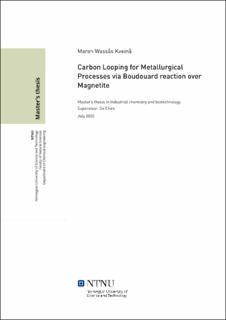| dc.contributor.advisor | Chen, De | |
| dc.contributor.advisor | Rout, Kumar R. | |
| dc.contributor.advisor | Cazzolaro, Martina | |
| dc.contributor.author | Kveinå, Maren Wassås | |
| dc.date.accessioned | 2021-09-28T18:23:34Z | |
| dc.date.available | 2021-09-28T18:23:34Z | |
| dc.date.issued | 2020 | |
| dc.identifier | no.ntnu:inspera:57621272:36620807 | |
| dc.identifier.uri | https://hdl.handle.net/11250/2785369 | |
| dc.description.abstract | Utvikling av en effektiv og økonomisk gunstig teknologi for reduksjon av CO2 utslipp i metallindustrien er et mål for å oppnå et fremtidig lav-utslipp samfunn. Karbotermisk reduksjon av metalloksider produserer en ovngass rik på CO, som typisk blir oksidert og slippet ut i atmosfæren. Målet med denne masteroppgaven er å utforske en ny strategi for å minske CO2 utslipp gjennom å resirkulere karbon; omgjøring av den CO-rike ovnsgassen til C og CO2 via Boudouard reaksjonen og implementering av karbon fangst.
Aspen Plus™ ble benyttet for ˚a estimere produkt distribusjonen ved termodynamisk likevekt, n˚ar en typisk CO-rik ovngass fra FeMn prosessen brukes som føde. Effekten av temperatur og partiell trykk av CO2 og H2 i føden ble undersøkt. Resultatene viser at høyere omdanning av CO og utbytte av C oppnås når temperaturen og partiell trykket av CO2 minskes og partiell trykket av H2 økes. Høyest karbon utbytte ble funnet for H2/CO ≈ 1.
Eksperimenter ble utført hvor den samme CO-rike ovnsgassen ble brukt som føde til et kjemisk dampavsetningsoppsett for produksjon av karbon nanofiber ved bruk av magnetitt katalysator. Det ble gjennomført undersøkelser på effekt av temperatur, mengde katalysator og PCO2 og PH2 i føden på omdanningen av CO, CO2, H2 og utbytte av C. Resultatene ble sammenlignet med resultatene fra Aspen Plus™ . Funnene viser at omdanning av CO og utbytte av C er avhengig av temperatur og fødekomposisjon. Høyest karbonutbytte (27.3 %) ble funnet ved CO2/CO = 0 og temperatur rundt 600°C. Røntgen-diffraksjon og Raman spektroskopi karakterisering av produsert karbon antydet veldig små krystalitt-dimensjoner.
Videre ble potensiell reduksjon av CO2 utslipp og reduksjonsmiddel estimert ved bruk av massebalanse for både Aspen Plus™ og eksperimentelle resultater. Reduksjonen av tonn CO2 utslipp/ton metall ble funnet til 10.8 og 3.7 %. Reduksjonen av tonn reduksjonsmiddel/tonn metall ble estimert til 21.7 og 7.3 %. Enda høyere reduksjonspotensiale ble funnet ved å halvere PCO2 i føden. | |
| dc.description.abstract | The development of efficient and cost-effective technology for the reduction of CO2 emissions in the metallurgical industry is a major objective for a future low-emission society. Carbothermal reduction of metal oxides produces CO-rich oven gas, which is typically oxidized and emitted to the atmosphere. This thesis aims to explore a novel strategy to decrease the CO2 emissions through closing the carbon loop; converting the CO-rich gas to C and CO2 via the Boudouard reaction.
Aspen Plus™ was used to evaluate the thermodynamic equilibrium product distribution when a CO-rich oven gas (from the FeMn process) was fed to a Gibbs reactor. Investigations on the effect of temperature as well as partial pressures of CO2 and H2 in the feed were performed. The results show higher CO conversion and C yield obtained by decreasing temperature and PCO2 in the feed as well as increasing PH2 in the feed to H2/CO ≈ 1.
Experiments were conducted feeding the same CO-rich gas mixture to a chemical vapor deposition setup for the production of carbon nanofibers in the presence of magnetite catalyst. Investigating the effect of temperature, catalyst loading and partial pressure of CO2 and H2 in the feed on the conversion of CO, H2, CO2 and yield of carbon, compared to the Aspen Plus™ results. The experiments conversion of CO and yield of C is dependent on temperature as well as feed composition. The highest C yield (23.7 %) was obtained feeding CO2/CO = 0 at a temperature around 600°C. Furthermore, characterization of the produced carbon by X-ray diffraction and Raman spectroscopy suggests formation of carbon with very small crystallite dimensions.
The potential reduction in CO2 emissions and required reducing agent were estimated by a mass balance approach on both Aspen Plus™ and experimental results. The results show potential in reducing the ton CO2 emitted per ton metal produced by 10.8 and 3.7 %. Finally, the potential reduction of ton fresh reducing agent were estimated to 21.7 and 7.3 %. Even higher reduction potential was found by halving PCO2 in feed. | |
| dc.language | | |
| dc.publisher | NTNU | |
| dc.title | Carbon Looping for Metallurgical Processes via Boudouard reaction over Magnetite | |
| dc.type | Master thesis | |
